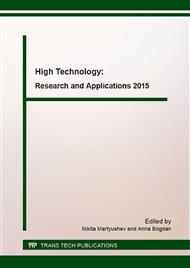p.350
p.355
p.360
p.365
p.370
p.375
p.380
p.385
p.389
The Statistical Analysis of Granulometric Composition and Microgeometrical Indicators of Abrasive Grains of Grinding Wheels for Rough Machining
Abstract:
The analysis of geometry of abrasive grains on macrogeometrical and microgeometrical indicators is carried out; charts of distribution of these indicators are submitted. The research technique based on application of photometry for obtaining digital images of abrasive grains is described. On the basis of this method we have established that abrasive grains can be devided into following form types: isometric, beam-type, and laminar. Grains sharpening and peaks rounding radii R in samples scanning plane were investigated in order to analyse abrasive grains microgeometry. Statistic analysis provided following results: average grain sharpening angle is within limits of 85° ≤ β ≤ 90°; average grain peak rounding radius is equal to 0.2 ≤ R ≤ 0.4 mm.
Info:
Periodical:
Pages:
370-374
Citation:
Online since:
February 2016
Authors:
Price:
Сopyright:
© 2016 Trans Tech Publications Ltd. All Rights Reserved
Share:
Citation:


